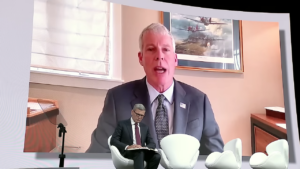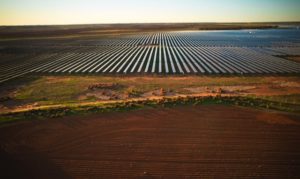A power struggle is brewing over what will be one of the most important components of Australia’s future grid – wholesale demand response – as industry incumbents shape up against specialist newcomers in the fight for this precious consumer resource.
This particular battle, which has seen new shots fired just this week, is over who should get to control the emerging demand response market, which – loosely defined – manages the consumption of electricity customers to better match supply with demand.
New developments in the debate come ahead of this week’s annual review of the state of retail competition in the energy sector, due to be tabled by the Australian Energy Market Commission on Friday.
As part of its focus this year, the AEMC review asks if the market is delivering for small customers and what needs to happen to improve outcomes for households and small business in the years ahead.
But as Craig Memery from the Public Interest Advocacy Centre tweeted on Tuesday, another question worth asking is: “Are energy retailers acting in consumers’ interest and optimising wholesale demand response, or acting in their own interests and blocking it?”
Q. Are energy retailers acting in consumers’ interest and optimising wholesale demand response, or acting in their own interests and blocking it?
A. See this thread… https://t.co/zb1MqNtDdy
— Craig Memery (@craigmemery) June 25, 2019
It’s a really important question at a really important time for Australian consumers, who have invested in solar at a world-leading rate, to take better control of their energy supply, and now have the chance to cut their bills further by better managing their demand – and by doing so as a service to the grid.
So what is demand response? The oft-misunderstood electricity market mechanism – and no, it’s not about big business taking random control of your TV or air-con – has been around for some time, although mostly in the ancillary market in the form of industrial load shifting at times of peak power demand.
The wholesale market version – which everyone from the Australian Energy Market Operator to the incumbent industry giants agrees will be vital to our increasingly distributed renewable networks – is about harnessing and managing the “negawatts,” or energy not used by businesses and homes, to optimise the security and efficiency of the grid.
“A (wholesale demand response market) will provide a more effective and efficient energy wholesale market, by displacing more costly generation capacity and dispatch with more cost-effective voluntary load reductions,” PIAC says in a submission to the Austrailan Energy Market Commisson from Januray this year.
“This will in turn place downward pressure on wholesale prices and reduce concentration, while improving options for cost effectively maintaining system security and reliability.”
“From Texas to Taiwan, demand response has been proven to be a cost-effective way to manage demand at peak times and act as a contingency to avoid disruptive power outages,” AEMO chief Audrey Zibelman has said.
And research and pilot programs have shown that, given all of the relevant and correct information, most consumers are up for it – particularly as there are various rewards for participation, including reduced power bills.
But, as Memery and Mark Byrne from Total Environment Centre (TEC) wrote here earlier in the year, “crazily, AEMO can’t pay people to do demand response in the wholesale market, even on hot days when generators are dropping like flies and those that are still running are being paid $14,500/MWh.”
The good news is that the Australian Energy Market Commission is considering a rule change to remedy this situation – a rule change that has been proposed to the AEMC by The Australia Institute (TAI), TEC and PIAC.
As TAI’s Ben Oquist explained it this week, in an open letter renewing the push for the reform, the proposed rule change seeks to allow demand response companies to freely enter the market.
“Industrial, agricultural and household consumers are paying too much for electricity. Reliability is under pressure and Australia lacks a durable policy for appropriate emissions reduction in the electricity sector,” the letter – co-signed by the Australian Industry Group, BlueScope Steel, CSR Limited and the National Irrigators Council, among others.
“One of the best ways to address this energy trilemma is to cut peak demand, through wholesale demand response.”
“Demand response competition represents an ideal opportunity for the Morrison government that would help protect reliability and lower prices as coal power retires,” said Oquist, who is executive director of TAI.
But as the letter also notes, the retailers – including those that form part of vertically integrated companies that also generate power – want to prevent their customers becoming their competition.
So, says Oquist, “they have put in an alternative rule change that locks up the market, which has rightly been rejected by the ACCC.”
This tussle over who should be able to put their fingers in the demand response pie was well illustrated on ABC TV’s 7.30 program on Tuesday night.
“The energy companies are opposing demand response because they know it means competition, and competition means lower profits,” TAI’s Dan Cass told 7.30.
“It’s that simple: it will benefit consumers if we get this reform, and they are standing in the way.”
This argument is teased out a little more here by Memery and Byrne:
“The big retailers who have their own power plants have the most to lose, and are leading the charge against the demand response market reform,” they write.
“In fact, some (commercial and industrial) customers are explicitly forbidden, as part of the contract with their retailer, from doing demand response.”
But it gets more complicated. According to Memery and Byrne, “big gentailers are joined in opposing demand response reforms like the wholesale demand response mechanism by some smaller retailers, who have niche demand response deals with their own customers and don’t want to face more competition.”
“Yet it is supported by most other stakeholders including state governments, networks and large C&I and small consumer advocates.”
Also shaping up against the reform is industry representative, the Australian Energy Council.
“We don’t see that there is any need for demand response to be delivered by anyone other than retailers and their customers,” said the AEC’s Sarah McNamara on 7.30.
But in a submission to the AEMC in January this year, the PIAC notes that the retailers haven’t exactly done a great job on demand response so far, despite currently being solely responsible for facilitating consumer participation in the market.
“Residential consumers have been given little or no opportunity to participate in WDR (wholesale demand response),” the submission says.
“PIAC has observed that there has been a very recent burst of ad-hoc [demand response] activity from a small number of retailers. Rather than a sign of enough progress in retailer-offered WDR services, this appears to be an attempt to head off this reform process,” it says.
“The AER, in its recent wholesale electricity market performance report, observed that WDR by retailers has actually decreased in the last year, noting: ‘For summer 2017–18, AEMO estimated there was only 207MW of expected demand response to different wholesale price levels.”
And in another submission, also from January 2019: “Generators and retailers are threatened by competition from a WDR mechanism, and have lobbied strongly against one being implemented.
“Though much credible analysis has shown a WDRM to be in the long-term interest of consumers, gentailers themselves have consistently failed to tap into the material amount of demand response that is available to them, and they have so far been successful in their lobbying.
“This has resulted in ongoing detriment to consumers who continue to incur the cost of inefficient retail prices as DR remains underutilised. This is an unacceptable outcome, and a WDR mechanism is required to ensure that it does not remain the case.”
A draft determination by the AEMC on the proposed rule change, introducing a wholesale demand response mechanism is expected by 18 July.










